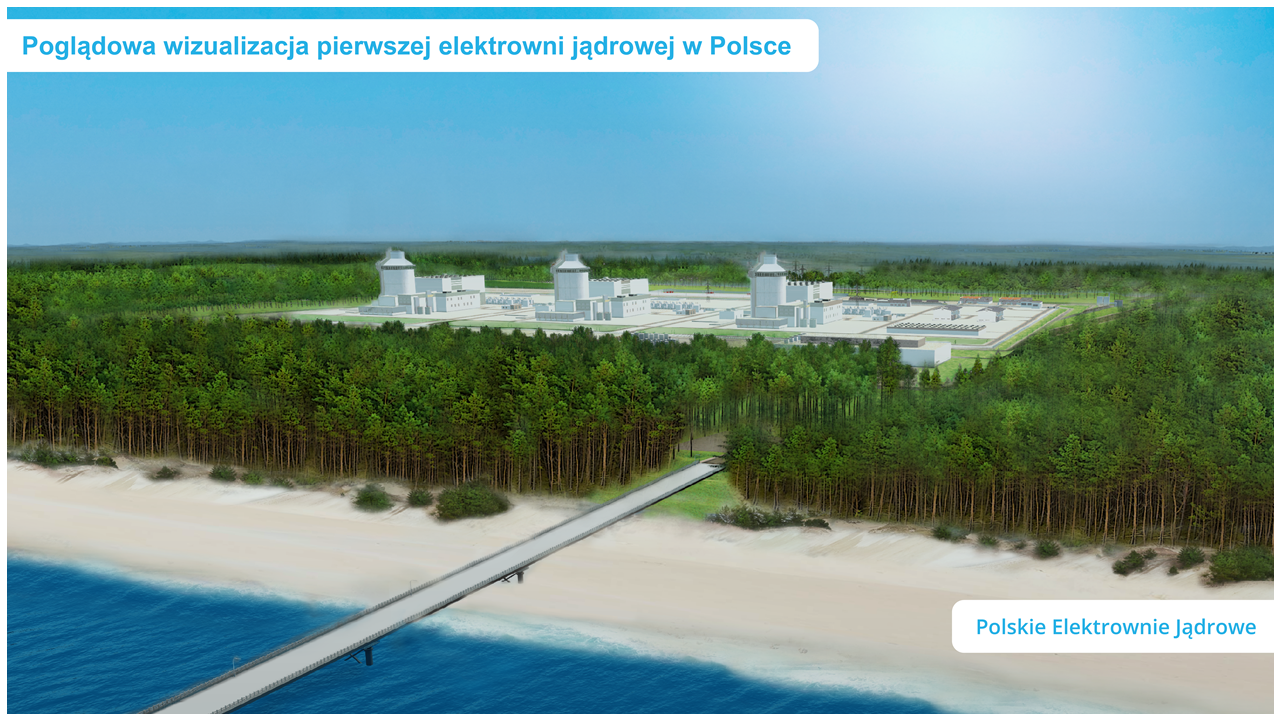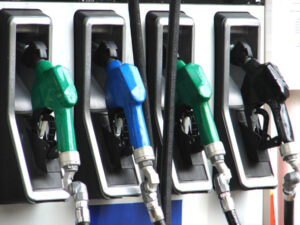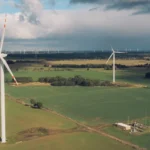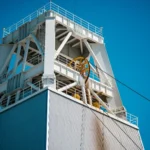The unregulated collaboration between nuclear and renewable energy sources may lead to them competing with each other detrimentally. Interest groups have started a new fight for Polish hearts, but a risk that the gas trap will return is lurking too – writes Wojciech Jakóbik, editor-in-chief at BiznesAlert.pl.
Polish nuclear power plant in Pomerania. Visualization: Polish Nuclear Power Plants.
- The financing of Poland’s nuclear power plant is up in the air. The project requires a 30 percent capital contribution and 70 percent debt financing. There is still no guarantee from the Treasury. The request for notification is to go to the European Commission in July, while the cost is estimated to grow from 100 to 150 billion without interest – Jakóbik says.
- Proponents of the atom engaged in the debate about the security of energy supply recognize that because conventional power plants are not flexible, their constant switching on and off threatens their technical durability. This is the case now with coal power, and in the future it will be with the atom. Thus, in order to avoid cannibalization we may need to reduce renewables in order to protect NPPs.
- Contrary to the arguments of some of the participants in the debate on energy security, we will still need power plants to operate as baseload. This has been confirmed in a report prepared by a Commission for Energy Transition of the Germany Economy Ministry, who are hard to accuse of lacking support for changes in the energy sector – the author points out.
Nuclear power is needed despite problems
Polls regularly show that over 80 percent of Poles support nuclear power. Being opposed to NPPs is very difficult politically. However, a new economic argument is emerging, resulting from inflation affecting the atomic project as well as the economy as a whole.
The financing of Poland’s nuclear power plant is up in the air. It requires a 30 percent capital contribution and 70 percent debt financing. There is still no guarantee from the Treasury. The request for notification is expected to reach the European Commission in July, while the cost is estimated to increase from 100 to 150 billion PLN without interest. The Commission would have to agree to this form of support at the turn of the first and second quarters of 2025.
The Government Plenipotentiary for Strategic Energy Infrastructure Minister Maciej Bando announced to the Polish Press Agency (PAP) that arrangements are underway with the Ministry of Finance on the act on financing the first nuclear power plant in the amount of PLN 60 billion that will go to the account of Polish Nuclear Power Plants (PEJ) along with the schedule. The government plans to pass the law this year to start collecting loans. If 60 billion PLN represents the mentioned 30 percent of Poles’ capital contribution to the nuclear project in Pomerania, then 100 percent equals 200 billion PLN, which suggests that 50 billion PLN is the cost of capital.
Maciej Bando has also mentioned solutions that will ensure nuclear power has a guaranteed base load, despite the irregularity of renewable energy sources that yield variable supply dependent on weather conditions. „We have a chance to design the generation structure in such a way as to balance the effect of all non-carbon sources. My goal is to propose a pathway to a production structure where zero-emission sources do not cannibalize each other, and each operates for the maximum possible time,” he said, as quoted by PAP.
Cannibalization, nuclear power and renewables
Marcin Popkiewicz, known for his criticism of nuclear power and supporting replacing it with a combination of RES and biomass, has commented on these calculations on Facebook. „I understand that Uncle Sam is our key geopolitical partner and we have already promised him that we will spend a lot of money on him, but as it is, we really could instead buy from the Americans not 3.5 GW of nuclear power, but something with greater added value,” he assesses referring to the AP1000 technology from Westinghouse chosen for the location in Pomerania. „For example, this money buys 35-40 GW of onshore wind turbines from GE or 200 GWh of megapacks from Tesla,” he claims.
Proponents of the atom engaged in the debate about the security of energy supply recognize that the lack of flexibility of conventional power plants means that their constant switching on and off threatens their technical durability. This is the case now with coal power, and in the future it will be with the atom. Thus, avoiding cannibalization may mean the need to reduce renewables in order to protect nuclear power. This is why supporters of renewable energy are reluctant.
On the other hand, as the engineers of the energy sector say behind the scenes, a nuclear power plant guarantees staple power supply. It can contract a specified amount of power in a timely manner. This is a function that is worth paying for, because a system that works without a baseload still does not work in the world. It is for this reason that the whole world is talking about new nuclear reactors and the price of uranium is rising. Demand is probably also one of the reasons for the increase in the cost of nuclear energy.
The gas trap is back
Contrary to the arguments of some of the participants in the debate on energy security, power plants will still be needed to operate as baseload. This has been confirmed in a report prepared by a Commission for Energy Transition of the Germany Economy Ministry, who are hard to accuse of lacking support for changes in the energy sector Its latest findings, dated June 26, show that the share of renewables in the energy mix reached 51.6 percent in 2023. However, the sooner Germany moves away from coal, the sooner it will need other capacities in baseload and that is why the construction of 10-15 GW of gas capacity is so important. Representatives of the Commission argue that it will then be necessary to convert them from natural gas to hydrogen, but for now it is too expensive a solution. The Commission concludes that even if Germany can achieve 10 GW of hydrogen production with electrolysers in 2030, it will not be enough to meet the demand for new gas-fired power plants. Thus it recommends diversifying the supply of natural gas.
One of the arguments for the atom from the Polish Nuclear Energy Program is to reduce dependence on gas. Opponents of atomic power in Poland using the argument of biomethane may therefore condemn Poland’s power generation to dependence on natural gas, if our less developed market will have problems with the implementation of renewable gases (biomethane, hydrogen) like Germany. This means we and we alone are setting up a gas trap, in which dictator Vladimir Putin once wanted to ensnare entire Europe.
So, instead of waging a Polish-Polish war, maybe we could implement the project in Pomerania and reconcile the atom with renewable sources so as to ensure the security of energy supply and the best possible cooperation between them, while reducing dependence on natural gas until we can figure out how to get enough of the renewable ones?









